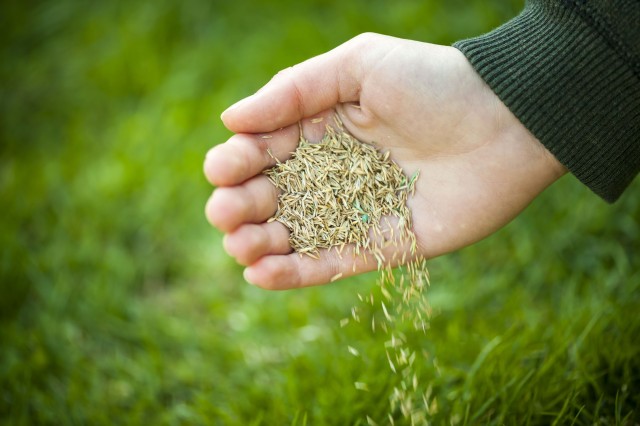 Late August through early October is the best time to aerate and overseed. Before overseeding your lawn, you should first determine what types of cool season grasses would perform best in your location. In North Alabama, a blend of turf-type Tall Fescue generally works best. Blends usually contain 3-5 different varieties of fescue with different qualities that perform best in certain conditions. Some blends may be more disease resistant, heat or drought resistant, or more shade tolerant. We recommend using a blend of seed that accommodates all the conditions that may occur during a regular growing season. Blended seeds keep the homeowner from having to decide which seed works best in each different environment.
Late August through early October is the best time to aerate and overseed. Before overseeding your lawn, you should first determine what types of cool season grasses would perform best in your location. In North Alabama, a blend of turf-type Tall Fescue generally works best. Blends usually contain 3-5 different varieties of fescue with different qualities that perform best in certain conditions. Some blends may be more disease resistant, heat or drought resistant, or more shade tolerant. We recommend using a blend of seed that accommodates all the conditions that may occur during a regular growing season. Blended seeds keep the homeowner from having to decide which seed works best in each different environment.
What Type of Seed Should You Use?
TDI uses Pennington® gold-tag certified sod-quality seed coated with mycorrhizae fungi. Gold-tag certification ensures that the seed we use is 100% weed seed free. The mycorrhizae fungi coating ensures quicker germination and the active beneficial fungi work symbiotically with grass plant roots to provide essential nutrients and enzymes that plants need to mature and thrive. The micro-organisms help retain moisture in the soil during stressful summer months when conditions for healthy cool season grasses decline.
Be Sure to Properly Aerate Before Overseeding
Prior to overseeding, we recommend aerating the areas that need seeding, or the entire lawn if required. This allows for better seed-to-soil contact which greatly improves germination and enables improved root growth and plant maturity. It is suggested to use 4-8 lbs. per 1,000 square feet. Higher rates such as 8 lbs. per 1,000 square feet are needed for bare ground situations while 4-6 lbs. per 1,000 square feet works great in established lawns. It’s best to purchase enough seed to have extra seed in case there are any areas that wash during a heavy rain, or for areas that may not have been seeded correctly. This gives a uniform appearance over the entirety of the lawn.
Once aeration and overseeding have been performed, you will need proper watering and fertilization to ensure quick germination and growth. During the first two weeks, water 2 times a day for 15-20 minutes per zone to get the seed to germinate. Once the new seedlings have germinated, it is important to never let the seedlings get too dry. Watering 3-4 days per week and 30-45 minutes per zone will be sufficient in most conditions. The end result would be at least 1.5 inches of water per week on the lawn. This is a good rule of thumb but may need to be adjusted during overly wet or severe dry periods.
After the new seedlings have germinated and grown, it is best to wait to remove any weeds until the new turf has been mowed at least 3 times. Since most of the weeds will be summer varieties and will die with the first frost, it is best to wait 8-10 weeks before applying any type of weed controls. Regular weed treatments, mowing, watering, and fertilization will then give you the best lawn in the neighborhood.
If you still have any questions or would like to speak with one of the professionals at TDI Lawn and Pest, please contact us.
